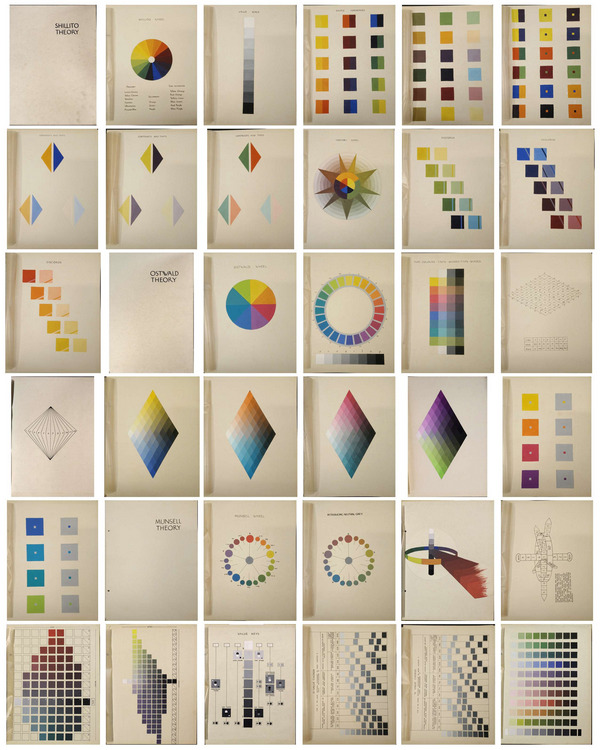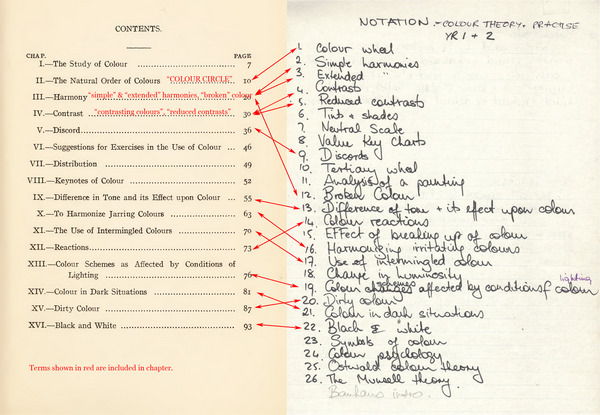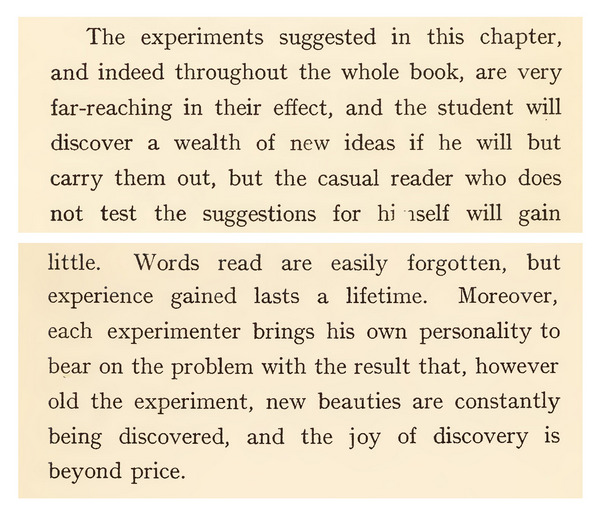I'm proud to announce that
my colour short course is
now offered online through
Australia's National Art
School in Sydney! There's
a choice of two sessions to
suit every time zone. LINK
my colour short course is
now offered online through
Australia's National Art
School in Sydney! There's
a choice of two sessions to
suit every time zone. LINK
Home
The Dimensions of Colour
Basics of Light and Shade
Basics of Colour Vision
Additive Mixing
Subtractive Mixing
Mixing of Paints
Hue
Lightness and Chroma
Brightness and Saturation
Principles of Colour
Afterthoughts
- Purves and Lotto
- Modern Colour Theory
- Traditional Colour Theory
- What is Color?
- Answers
- Colour Constancy Illusions
- The Colour Quiz
- What is a Colour?
- Colour Education
- Color Impact 2020
- Color Attributes
- Shillito portfolio
- Dimensions Today
- Index of Works
- Psychophysical
- Shillito Paper
- Elements of Colour
- Objects and Light
Glossary
References
Contact
Links
NEXT COLOUR
WORKSHOPS

11.12 A Shillito Student Portfolio from the Mid-1940’s
This page is coauthored with Eva Fay FDIA (https://www.evafaycolour.com.au/).
Overview of the portfolio boards. Click here to enlarge.
Our image above shows the complete set of boards from a remarkable portfolio of colour exercises and notes produced at the East Sydney Technical College (now the National Art School, Sydney) by Helen Jean Burgess (1926-2018) while she was a student in the Design diploma course in 1943-47. The portfolio is important as an early record of the colour curriculum of Phyllis Sykes Shillito (1895 – 1980), who was a major influence on colour design education in Australia from the 1920’s to the 1970’s (Kent, 1995) and an indirect influence on subsequent colour education in both design and fine art courses in Australia through her former students, including one of us (Eva Fay). The portfolio is available for inspection by appointment at the Caroline Simpson Library & Research Collection at the Sydney Royal Mint, whose catalogue entry for the item includes a biographical note on Helen Jean Burgess. We'd like to thank Michael Lech, Curator of the CSLRC for giving us permission to take and post these photographs.
Burgess’ portfolio comprises a woven fabric front cover and 36 loose boards divided into three sections, "Shillito Theory" (13 boards), "Ostwald Theory" (12 boards) and "Munsell Theory" (11 boards). Thirty of these boards feature renderings in gouache that range in complexity from a simple nine-step value scale to intricate Ostwald and Munsell pages that each required careful mixing in gouache of dozens of colour chips. The portfolio also includes six annotated transparent overlays, three pen and ink versions of Munsell and Ostwald diagrams, and 35 part-sheets or full sheets of typed text attached to the reverse sides of 24 of the boards. One of us (David Briggs) has examined these sheets in detail and found that in their entirety they closely paraphrase or copy verbatim passages from a total of just seven texts, and we have specified the sources individually for all 35 sheets in a more detailed report that has been accepted for presentation at the AIC 2022 meeting in Toronto, Canada.. The only substantial modifications are that on a few of the sheets Shillito's unique 15-step hue classification replaces the hue terms in the source. Some of the passages on these sheets also appear in typed or handwritten pages included in other Shillito student portfolios of the later 1940's and 1950's.
The typed notes in the "Shillito Theory" section all derive from Henry Barrett Carpenter's Suggestions for the Study of Colour (Carpenter, 1915, 1923), and the plates in this section illustrate “Simple Harmonies” and “Discords” in the sense that these constructs were defined by Carpenter, plus “Pure Colours, Tints and Shades”, “Contrasts and Tints”, a grey scale, and two “colour wheel” diagrams designed by Shillito (row 1, image 2; row two, image 4). The notes in the “Ostwald Theory” and "Munsell Theory" sections all derive from Maitland Graves' The Art of Color and Design (1941) and five texts on the Munsell and Ostwald systems and theories of colour harmony. The plates in the “Munsell Theory” section include gouache renderings (row 6, images 3, 4 and 5) of three pages from Graves' book, which had been published just a few years earlier (pp. 137, 156, and 162 respectively). These pages illustrate Graves' concepts of "value keys" ("High Minor", "Low Major" etc.) and "value chords", which he devised as a means of systematically classifying value distributions in design in relation to the Munsell value scale. Graves’ textbook proved to be highly influential and his concepts of “value keys” and “value chords” still find application today in both painting and design. Exercises rendering Graves’ "value key" and "value chord" diagrams and applying these concepts to design exercises were retained through to the end of Shillito’s teaching career (for examples, see Fay, 2021, pp. 37-38).
We believe that the typed sheets are likely to be typed-up lecture notes. One of us (Eva Fay) studied at the Shillito Design School in the late 1970’s and still possesses the notes that she copied down during lectures at the School, including the complete "Colour" component of the course. Our examination of these lecture notes from 30 years later shows that they also closely paraphrase or copy verbatim many of the same sources, including Graves and especially Carpenter, with some additions near the end of the course including notes on colour symbolism, colour psychology and the Bauhaus. Although Eva Fay recalls that Carpenter was not mentioned in class, her lecture notes contain many subject headings and long passages taken more or less verbatim from Carpenter’s book, including notes under the headings “Harmonies” (including “simple harmony” and “extended harmony”, as described in Carpenter, Ch. III, “Harmony”), “Contrasts” (including “reduced contrasts”, as described in Ch. IV, “Contrasts”), “Discords” (cf. Ch. V, “Discord”), “Broken colour” (cf. Ch. III, “Harmony”, p. 25, “The breaking of a colour ...”), “Differences in tone and its effect upon colour” (cf. Ch. IX, “Differences in Tone and its Effect Upon Colour”), “Colour reactions” (cf. Ch. XII, “Reactions”), “Harmonizing jarring or irritating colours” (cf. Ch. X, “To Harmonize Jarring Colours”), “Use of intermingled colour” (cf. Ch. XI, “The Use of Intermingled Colours”), “Colour schemes affected by conditions of lighting” (cf. Ch. XIII, “Colour Schemes Affected by Conditions of Lighting”, “Dirty colour” (cf. Ch. XV, “Dirty Colour”), “Colour in dark situations” (cf. Ch. XIV, “Colour in Dark Situations”), and “Black and white” (cf. Ch. XVI, “Black and White”). Eva also recalls that Graves’ book was mentioned and was available in class in some of the sessions in which his classification was discussed.
Left: Contents page of Carpenter’s Suggestions for the Study of Colour (2nd edn, 1923). Right: Scan from Eva Fay’s “Colour” lecture notes from the Shillito Design School in 1976-77 showing the list of lecture topics for this component of the course. Click here to enlarge.
Comparison of the Burgess portfolio of the mid-1940's with Shillito's colour exercises in the late 1970's (discussed by O'Connor, 2013, and individually illustrated and described by Fay, 2021), suggests that throughout this period, Shillito's colour teaching emphasized the intimate grasp of colour relationships that can be obtained through many hours of meticulous practical colour manipulation in paints, whether in copying Ostwald and Munsell hue pages in the 1940's or in rendering more creative colour design exercises in the the 1970's. Another aspect of the Shillito colour curriculum that compares very favourably to much colour education today was the level of attention paid to a systematic, three-dimensional understanding of colour organization. In the 1940's, this was presented in the context of the two major scientific colour order systems used in art and design at the time, alongside Shillito's own palette-based hue system. By the late 1970's the Ostwald system had declined in influence globally, and three-dimensional colour organization at the Shillito Design School was presented primarily in terms of the Munsell paradigm of hue, lightness ("tone") and chroma ("intensity"), but we have little doubt that today Shillito would discuss both the Munsell and the NCS frameworks.
Henry Barrett Carpenter's concepts set out in his book Suggestions for the study of colour evidently formed the backbone of the Shillito’s colour theory classes from at least the mid 1940’s to the late 1970’s. In fact, given that Carpenter was headmaster of the Rochdale School of Art, Manchester, only a short distance from the Halifax Technical College in South West Yorkshire where Shillito studied and also taught classes before coming to Australia, it’s likely that Shillito knew of Carpenter’s book from the beginning of her teaching career. Carpenter’s book was one of a number of popular texts for artists and designers that built on concepts derived from Ogden Rood’s Modern Chromatics of 1879, which was in turn a popularization of the new scientific view of colour ushered in by Helmholtz, Maxwell and others beginning in the 1850’s. Other such texts include Emily Vanderpoel’s Color Problems of 1901 and Albert Munsell’s A Color Notation of 1905, but Carpenter’s approach stands out for its emphasis on learning about colour through exercises and experimentation. Carpenter expressed the hope that his key concepts, which were presented to Shillito students more or less verbatim, would be of use to students of fine art as well as design, and we are pleased to note that this has been confirmed by an artist and art teacher of the standing of Jocelyn Maughan OAM (see Fay, 2021, Foreword).
Final paragraph from Carpenter’s Suggestions for the Study of Colour (2nd edn, 1923, pp. 98-99)
We’d like to emphasize that we are discussing here only the “Colour” component of Shillito’s colour and design curriculum. Shillito’s mature method of teaching was unique in that apart from doing exercises in colour theory classes and having critical discussion at that point, the colour application to each design exercise was also followed up with further critiques in the design and design application section of the curriculum. Eva Fay recalls that students at the Shillito Design School were often given minimal instruction and learnt principles of colour application by experimentation, discovery, observation and discussion. Sometimes weeks were spent doing one exercise in various colour combinations juxtaposing different hue, tonal (lightness) and/or intensty (chroma) variations.
David Briggs
Eva Fay
February 11, 2022
References
Carpenter, H. B, 1923. Suggestions for the study of colour (2nd edition; first edition published 1915). H. B. Carpenter School of Art: Rochdale. Available online at https://archive.org/details/b30009339
Fay, E., 2021. Shillito Design School. Australian colour education in the 70’s. Blurb.com. https://au.blurb.com/b/10737055-shillito-design-school-australian-colour-educatio
Graves, M. E., 1941. The art of color and design. New York: McGraw-Hill. Available online at https://archive.org/details/artofcolordesign00grav
Kent, C. J., 1995. Phyllis Shillito (1895-1980): A review. Master’s thesis, Faculty of Design, Architecture and Building, University of Technology, Sydney; 1995. https://opus.lib.uts.edu.au/handle/10453/32317
O’Connor, Z., 2013. The Shillito Design School: Australia’s link with the Bauhaus. The International Journal of Design in Society, 6 (3), 149-159.



